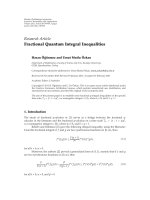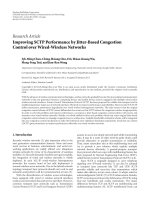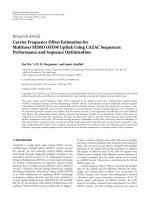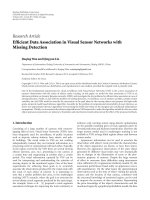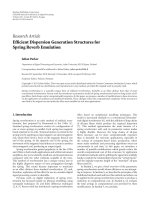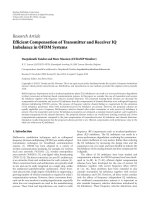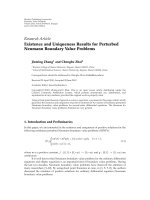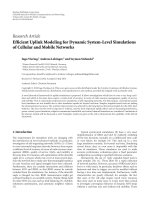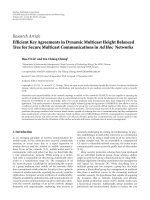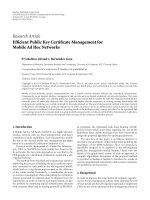Báo cáo hóa học: "Research Article Efficient MAC Protocol for Subcarrier-Wise Rate Adaptation over WLAN" potx
Bạn đang xem bản rút gọn của tài liệu. Xem và tải ngay bản đầy đủ của tài liệu tại đây (733.36 KB, 9 trang )
Hindawi Publishing Corporation
EURASIP Journal on Wireless Communications and Networking
Volume 2010, Article ID 264838, 9 pages
doi:10.1155/2010/264838
Research Article
Efficient MAC Protocol for Subcarrier-Wise Rate
Adaptation over WL A N
Sung Won Kim,
1
Byung-Seo Kim,
2
andSungBackHong
3
1
Department of Information and Communication Engineering, Yeungnam University, Gyeongsangbuk-do 712-749, Republic of Korea
2
Depar tment of Computer and Information Communication Engineering, HongIk University, Jochiwon,
Chungcheongnam-do 339-701, Republic of Korea
3
Future Network Research Department, Electronics and Telecommunications Research Institute (ETRI),
Daejeon 305-700, Republic of Korea
Correspondence should be addressed to Byung-Seo Kim,
Received 1 October 2009; Revised 9 March 2010; Accepted 18 May 2010
Academic Editor: Wolfgang H. Gerstacker
Copyright © 2010 Sung Won Kim et al. This isan open access article distributed under the Creative Commons Attribution License,
which permits unrestricted use, distribution, and reproduction in any medium, provided the original work is properly cited.
While bit-loading algorithms over wireless systems have been extensively studied, the development of a protocol which implements
bit-loading-based rate adaptation over wireless systems has not been highlighted. The design of such a protocol is not a trivial
problem, due to the overhead associated with the feedback information. In this paper, a novel protocol is proposed to provide an
efficient way to implement subcarrier-wise rate adaptation in OFDM-based wireless systems. When receiving a Ready-To-Send
(RTS) packet, the receiver determines the number of bits to be allocated on each subcarrier through channel estimation. This
decision is delivered to the sender using an additional OFDM symbol in the Clear-To-Send (CTS) packet. That is, bit-allocation
over subcarriers is achieved using only one additional OFDM symbol. The protocol enhances the channel efficiency in spite of the
overhead of one additional OFDM symbol.
1. Introduction
Wireless communication is experiencing an explosive growth
of rate demand. The high demand for wireless communica-
tion services requires increased system capacity. Orthogonal
Frequency Division Multiplexing (OFDM) is a promising
technology allowing wireless networks to provide high spec-
tral efficiency into relatively small spectrum bandwidths. The
attention has been focused on the application of the OFDM
in the wireless local area network (WLAN). The existing
examples of these systems are IEEE802.11a and HIPERLAN-
2 standards which have chosen OFDM as a modulation
scheme due to its good performance in multipath fading
environment and its robustness against intersymbol interfer-
ence.
Conventional rate-adaptive OFDM-based wireless sys-
tems use a fixed constellation size and power level over all
subcarriers, as in the case of the IEEE802.11a standard [1–
3].However,allorsomeofthesubcarriersexperience
different channel conditions due to multipath fading. As
a consequence, applying a different constellation size (or
number of bits or data rate) to each subcarrier according
to its channel condition provides more reliable and efficient
data transmission than applying the same constellation size
to all subcarriers.
The allocation of a unique number of bits to all subcar-
riers in an OFDM symbol, called bit-loading, has been used
in wired communication systems, such as digital subscriber
lines (DSLs). Since the wired channel is slowly time-varying,
the receiver can provide reliable channel state information
to the transmitter using robust feedback channel. Therefore,
adaptively loading the carriers seems to be an interesting
approach for increasing the channel utilization. The the-
oretical channel capacity can be achieved by distributing
the total transmitted energy according to the water-filling
principle [4]. However, this distribution has computational
complexity and assumes infinite granularity in constellation
size. In the realistic case where a finite granularity in
constellation size is required, the rounded bit distribution
obtained starting from the water-filling solution could still
2 EURASIP Journal on Wireless Communications and Networking
not be the optimum. Some suboptimum algorithms to
reduce the complexity have been proposed in [5–7].
The performance of wireless networks is degraded by
the adoption of the bit-loading scheme, since, unlike wired
channels, wireless channels have fast time-variant property.
The fast time-variant nature of wireless channels requires
more frequent changes in the number of bits allocated in the
subcarriers. Furthermore, since the sender and receiver have
to share this allocation information, frequent exchanges of
the bit-loading information between them are required. This
increases the overhead and, as a consequence, degrades the
network performance.
The problem of increased feedback overhead in cen-
tralized networks such as cellular systems may be less
severe than that in distributed networks, since all of the
terminals communicate with an Access Point (AP) and
the AP can control the feedback information without
disturbing the ongoing traffic. In addition to this, terminals
in centralized networks can periodically send Channel State
Information (CSI). However, in distributed networks such
as ad hoc networks, the communication occurs in a peer-
to-peer way and there is no such arbitrator. Therefore,
since each communication pair has to exchange its CSI,
more feedback packets are generated than in centralized
networks. In addition to this, since the feedback packets are
not controlled by an AP, collisions can occur with ongoing
packets. Furthermore, the volume of the feedback informa-
tion, including the subcarrier condition, increases as the
number of subcarriers increases. Therefore, in order to utilize
subcarrier-wise bit allocation in wireless ad hoc networks,
an efficient protocol with minimum feedback information is
required.
However, researches in this area have focused on allocat-
ing the optimal energy and rate and reducing the complexity
of the bit-loading calculation itself [8–13] with the assump-
tion of the availability of the feedback channel information.
On the other hand, little effort has been made to design effi-
cient protocols for bit loading in wireless networks. Design-
ing an efficient protocol is not a trivial problem, because
not only is the feedback information quite voluminous but
also the time-varying wireless channel requires frequent
transmissions of such large amounts of information. The
research in [12] targeted centralized networks; so it assumed
the existence of a central node which knows all the channel
conditions of all member nodes. Moreover, due to the slow
fading channel model used in this research, it does not
suffer from feedback overhead. In the method proposed in
[14], only the strongest subcarriers are used with high-order
constellation to meet the target total data rate. The receiver
informs the sender of the identification numbers (IDs) of the
subcarriers which will be used for the next data transmission.
Even though the feedback overhead is reduced to two OFDM
symbols, the method in [14] cannot fully utilize all of the
subcarriers. In effect, some of the chosen subcarriers may not
be strong enough to deal with the high-order constellation.
In addition, a separate feedback channel is used in [14].
Thus, such voluminous and frequent feedback information
does not deteriorate the performance of wireless networks.
However, all the previous works do not propose the feedback
method how the transmitter and receiver estimate and share
the dynamic channel status. To the best of our knowledge,
no work has been published about bit-loading in distributed
wireless networks with practical feedback overhead.
An efficient method of implementing subcarrier-wise
rate adaptation with minimum overhead over a wireless
system is proposed in this paper. The proposed method
requires only one additional OFDM symbol. In spite of the
overhead engendered by this additional OFDM symbol, the
network throughput and delay performances are improved.
In Section 2, the motivation for the development of the
proposed method is presented, followed by a detailed
description. In Section 3, the proposed method is evaluated
through simulations and the resultant performance improve-
ments are demonstrated. Finally, the conclusion is given in
Section 4.
2. Subcarrier-Wise Rate Adaptation with
Minimum Overhead over WLANs
The proposed protocol is designed for WLANs with heavy
traffic such as those including the download of large size
files (music, video, documents, etc.). It is assumed that the
wireless stations move at pedestrian speed so that the wireless
channel changes slowly. The method proposed in this paper
is based on the 4-way handshaking mechanism composed
of RTS/CTS/DATA/ACK sequences specified in IEEE 802.11
[15].
The proposed method is based on the use of a Bit Map.
The Bit Map is a table recording and indicating how many
bits were or are allocated on each subcarrier of OFDM
symbols in a previous or current packet, respectively. In fact,
the number of bits is directly proportional to the data rate
of each subcarrier (data rate
= the number of bits/OFDM
symbol duration). In order to avoid confusion, hereinafter
we use only the data rate. The overall operation of the
protocol is as follows. The sender sends an RTS to the
receiver. When it receives the RTS, the receiver estimates the
condition of all subcarriers and determines the data rate that
can be sent on each of them. After updating its Bit Map, the
receiver sends a CTS packet, which uses a modified packet
format derived from the IEEE 802.11 standard. The detailed
CTS packet format is described in Section 2.2. The sender
updates its Bit Map according to the information embedded
in the CTS. The details of the method are illustrated in the
following subsections.
2.1. Bit Map. The Bit Map indicates how many bits are allo-
cated to each subcarrier in the OFDM symbol for the
communication between a pair of stations. It is located
in their internal memory. The stations generate the Bit
Map when a communication is initiated and maintain the
Bit Map for each communication pair. The Bit Maps of
a communication pair, namely, a sender and a receiver,
have to be synchronized with each other. The processes
employed to update and synchronize the Bit Maps of a sender
and a receiver will be detailed in Section 2.2.TheBitMap
stores the currently updated bit allocation information as
EURASIP Journal on Wireless Communications and Networking 3
t
t
− 1
2
3
3
3
Ch1 Ch2
Time
Index
Sub-channel
#
···
Ch n
3
3
Figure 1: An example of the Bit Map.
Bit map flag
4bits
Length
12 bits
Reserve
1bit
PLCP header
(one OFDM)
Bit map adjustment
(one OFDM)
Parity
1bits
Ta il
6bits
Preamble MPDU
Figure 2: OFDM symbol of Bit Map adjustment in CTS packet.
well as the previous allocation information. Figure 1 shows
an example of the Bit Map. t and t-1 in Time Index in
Figure 1 indicate the current and previous allocation times,
respectively.
2.2. Revise d Formats of CTS and DATA Packets. The method
proposed in this paper revises the packet formats of the CTS
and PLCP header in DATA. Figure 2 shows the packet format
of CTS and Figure 3 shows that of DATA. The “Rate” subfield
in the CTS PLCP Header of IEEE 802.11a is changed to a
Bit-Map-Flag subfield to indicate the use of the Bit Map.
When the Bit-Map-Flag subfield is set to 1111, a “Bit-Map-
Adjustment” OFDM symbol is inserted between the PLCP
header and MPDU. A Bit-Map-Flag with the value 0000
indicates that the Bit allocation is not changed, so that no
“Bit-Map-Adjustment” follows after the PLCP header. Since
the value of 1111 is reserved in the “Rate” subfield, the
modified CTS packet is compatible with legacy IEEE 802.11
devices.
This additional single OFDM symbol is composed of 48
data subcarriers and 4 parity subcarriers. Each parity bit
covers 12 subcarriers. Each subcarrier is set to 1/
−1 (BPSK)
or one of the BPSK symbols. The objective of this additional
OFDM symbol is to adjust the data rate allocated on
the subcarriers for the subsequent data transmission. The
method employed to allocate the data rate to each subcarrier
is described in the following subsection. For the DATA
packet, only one subfield is changed, as shown in Figure 3.
The “Reserved” subfield in the DATA PLCP header in IEEE
802.11a is used as a “Confirmation” subfield. This subfield
is used as an Acknowledgment for the Bit Map in the CTS
packet. If the sender agrees with the Bit Map, the bit is set
to 1. Otherwise, it is set to 0. The “Confirmation” subfield
is used for the error recovery process, which is described in
detail in Section 2.4.
In order to provide the backward compatibility of the
protocol with legacy devices, “Reserved” subfield in RTS
packet shown in Figure 4 is utilized. To negotiate the use
of the proposed rate adaptation method with the receiver,
a sender sends an RTS packet with “Reserved” subfield set
to 1. Receiving the RTS packet with “Reserved” subfield
set to 1, if the receiver is a node with the proposed rate
adaptation capability, it sends the proposed CTS packet
shown in Figure 2. Otherwise, it sends a conventional CTS
packet to the sender. By checking the value of “Rate”
subfield in the received CTS packet, the sender decides which
one of the transmission methods, the proposed method
or the legacy method, is carried out. As a result, the
proposed method is compatible with the operation of legacy
devices.
2.3. Rate Selection and Rate Change Procedure in Receiver.
The process used to update the data rate of each subcarrier
for a subsequent data transmission is as follows.
Step 1 (Negotiation of using the proposed subcarrier-wise
rate adaptation). A sender sends an RTS packet setting
“Rate” subfield in PLCP header to 1111. This informs
a receiver the use of the subcarrier-wise rate adaptation
method. If the receiver can process the proposed method, it
goes to the next steps. Otherwise, the receiver sends a legacy
CTS packet back to the sender and then the conventional
procedure as defined in IEEE 802.11 standard is processed.
Step 2 (Estimate the channel condition of each subcarrier
and find the optimal data rate). The channel condition of
a subcarrier (e.g., Signal-to-Noise Ratio (SNR)) is estimated
from the received RTS packet. The receiver chooses a data
rate suitable for the channel condition. We assume that the
data rate is selected based on the predetermined threshold
value [1–3].
Step 3 (Compare the chosen data rate with the data rate
in the Bit-Map). The chosen data rate for the subcarrier
is compared to the data rate in the current Bit-Map. After
comparison, the receiver chooses one of three actions: to
increase, decrease, or not to change the data rate on each
subcarrier. For example, if the data rate in the current Bit
4 EURASIP Journal on Wireless Communications and Networking
Rate
4bits
Length
12 bits
Confirmation
1bit
PLCP header
(one OFDM)
Parity
1bits
Ta il
6bits
Preamble
MPDU
Figure 3: Fig. 3. PLCP header structure with confirmation subfield in Data packet.
Rate
4bits
Length
12 bits
Reserve
1bit
PLCP header
(one OFDM)
Parity
1bits
Ta il
6bits
Preamble MPDU
Figure 4: Fig. 4. A conventional RTS packet.
Table 1: Data rate adjustment on each subcarrier according to
symbols assigned in bit-map-adjustment ofdm symbols.
Symbol on a
subcarrier in previous
Bit-Map-Adjustment
OFDM symbol
Symbol on a
subcarrier in current
Bit-Map Adjustment
OFDM symbol
Data rate
adjustment in Bit
Map
−1 −1
Decrease one level
from the previous
data rate
−1 1 Do not change
1
−1Donotchange
11
Increase one level
from the previous
data rate
Map is smaller than the chosen data rate, the receiver chooses
to increase the data rate for that subcarrier.
Step 4 (Set the value of the Bit-Map-Adjustment symbol of
the CTS). According to the decision in Step 2, the receiver
sets the Bit-Map-Adjustment symbol to 1 to increase or -1
to decrease the data rate on each subcarrier. If the decision
of a subcarrier is not to change the data rate, the receiver sets
the Bit-Map-Adjustment symbol to a different value from the
one used in the same subcarrier of the previous CTS.
Step 5 (Update the Bit-Map). Once the values of the Bit-
Map-Adjustment symbol are decided, the actual data rate
for the upcoming data transmission is selected according to
Ta bl e 1. Tabl e 1 illustrates how to choose the data rate based
on the values on both the current and previous CTS Bit-
Map-Adjustment OFDM symbols. As noted in Step 3, if the
current value is different from the value used in the previous
CTS, the data rate is not changed. The Bit-Map is updated
with the currently chosen data rates.
The rate transition diagram is shown in Figure 5. In the
figure, “
∗/∗” denotes “a value on a subcarrier of the current
CTS Bit Map Adjustment OFDM symbol/a value on a sub
channel of the previous CTS Bit Map Adjustment OFDM
symbol”, and K denotes the data rate in the current Bit Map.
2.4. Rate Change Procedure at a Sender and Error Recovery.
After the process illustrated in Section 2.3 is completed, the
receiver (i.e., the destination of the RTS packet) sends a CTS
packet to the sender (i.e., the source of the RTS packet).
The CTS packet includes the Bit-Map-Adjustment OFDM
symbol updated by the receiver. After receiving the CTS
packet, the sender also updates its own Bit Map following the
rule shown in Ta bl e 1. By using the data rates represented in
the updated Bit-Map, the sender generates and sends a DATA
packet with the “Confirmation” subfield set to 1. When the
receiver receives this DATA packet, it demodulates the packet
based on the Bit Map information and sends an ACK to the
sender.
This process is shown in Figure 6(a). If the sender fails to
receive an ACK packet, as shown in Figure 6(b),itchanges
the current data rate information to the previous informa-
tion contained in its previous Bit Map and retransmits an
RTS. When the receiver receives an RTS with a nonzero
retry bit, it changes the current data rate information to the
previous information contained in its previous Bit Map.
If the reception of the DATA packet at the sender fails
for some reason (e.g., channel error or collision), as shown
in Figure 7(a), the receiver changes the current data rate
information to the previous information contained in the
Bit Map. In this case, since an ACK will not be sent, the
sender also changes the current data rate information to the
previous information contained in its Bit Map.
If the transmission of the CTS packet fails, the receiver
goes back to the previous bit allocation information con-
tained in the Bit Map, as in the case of DATA packet loss.
This case is shown in Figure 7(b).
3. Performance Evaluation
A centralized WLAN system is simulated. The system is
composed of one AP and N stations. In the simulation, the
physical (PHY) layer defined in the IEEE 802.11a standard
is considered. The PHY layer has eight PHY modes charac-
terized by different modulation schemes and convolutional
EURASIP Journal on Wireless Communications and Networking 5
1/ − 1or−1/1
1/1
−1/ − 1
···
1/1
−1/ − 1
1/
− 1or−1/1
1/1
−1/ − 1
1/
− 1or−1/1
1/1
−1/ − 1
0
KK+1
Figure 5: Data rate transition diagram.
Table 2: IEEE 802.11a PHY modes.
Mode Modulation Code rate Data rate Minimum sensitivity (dBm)
1BPSK1/26Mbps −82
2BPSK3/49Mbps
−81
3QPSK1/212Mbps
−79
4QPSK3/418Mbps
−77
5 16-QAM 1/2 24 Mbps
−74
6 16-QAM 3/4 36 Mbps
−70
7 64-QAM 2/3 48 Mbps
−66
8 64-QAM 3/4 54 Mbps
−65
coding rates, as shown in Ta ble 2 .Moredetailscanbefound
in [16]. We use a Ricean fading broadband channel model.
All of the stations except for the AP are randomly distributed
in a circular area with a diameter of 100 meters and move
randomly at a speed of 1 m/sec. The AP is located at the
center of the area. The traffic load is saturated in each station.
The packet size is 1024 bytes.
For the purpose of the evaluation, the proposed method,
which is referred to as “Adaptive”, is compared with two
prior art methods. The first one is a method proposed in
[14] that is also briefly described in Section 1.Wename
this method “OSS”. The other one is a packet-based rate
adaptation method described in [2, 3, 17, 18], which changes
the data rate based on the channel condition, but uses the
same PHY mode over all subcarriers. Since this method uses
a fixed PHY mode over all subcarriers in an OFDM symbol,
we name it “Fixed”. “Fixed” chooses a data rate, which
is appropriate for a subcarrier having the worst channel
condition over all subcarriers. All three methods use the 4-
way handshaking procedure (RTS/CTS/DATA/ACK) defined
in the IEEE 802.11 standard. In terms of the overhead in the
control packets, such as RTS, CTS, and ACK, our method
has one more OFDM symbol compared to “Fixed” due to
the addition of the “Bit-Map-Adjustment” OFDM symbol.
Although it might need two or more OFDM symbols, we
assume that OSS also uses one OFDM symbol for the
feedback of the subcarrier information. In OSS, the threshold
level used to select the strongest subcarriers is set to 54 Mbps,
which corresponds to
−65 dBm in Ta ble 2 . Only the selected
strongest subcarriers are used for packet transmission, as
described in [14]. The value of
−65 dBm is selected as
the threshold level for OSS, because this level provides
the best throughput performance among the 8 levels in
Ta bl e 2.
Figure 8 shows the changes of the channel condition
(in Rx Power), the transmission rate (in Tx rate), and the
feedback bit as a function of time. The changes shown in
Figure 8 are for only one subcarrier. The received signal
power changes due to the fading channel. According to
the received signal power, the receiver sends the feedback
information, 1 or
−1, to change the data rate as described
in Section 2.3. When the transmission rate is lower than the
marginal rate, the receiver sends the feedback of 1 to increase
the rate. During the time duration of 0.1
∼ 0.2 sec, the
receiver sends the feedback of 1 four times consecutively and
the transmission rate increases to the maximum value. On
the contrary, during the time duration of 0.2
∼ 0.3 sec, there
are continuous feedbacks of
−1 and the transmission rate
decreases. In Figure 8, the transmission rate closely follows
the change of the channel condition, although not exactly.
The reason for this discrepancy is that the transmission of
the feedback information is not always available. Note that
the feedback happens only when there is a data packet in
the queue to be transmitted. Moreover, the feedback interval
varies because each station has to compete with the other
stations to have the opportunity to transmit.
Figure 9 shows the throughput performance improve-
ment of the proposed method over Ricean fading channel
with the Ricean parameter, 10. As the number of stations
increases, the number of collisions also increases. Because of
the increased number of collisions, each station has longer
average backoff window and waits more time to transmit
a data packet. Thus, the system throughput is degraded as
the number of stations increases. The proposed method,
“Adaptive”, provides an improvement in the throughput
ranging from 8% to 11.5% compared to the other two
methods. This is because the proposed method adapts
the data rate for each subcarrier dynamically according to
6 EURASIP Journal on Wireless Communications and Networking
Sender
RTS
Receiver
Channel estimation
Bit allocation
Update internal bit-map
Insert bit map
adjustment OFDM
symbol to CTS
Update internal bit-map
Set confirmation bit to 1
Check confirmation bit
Data demodulation
CTS
Data
ACK
(a)
Sender
RTS
Receiver
Channel estimation
Bit allocation
Update internal bit-map
Insert bit map
adjustment OFDM
symbol to CTS
Update internal bit-map
Set confirmation bit to 1
Check confirmation bit
Data demodulation
CTS
Data
ACK
RTS
CTS
Go back to previous bit-map
Set Retry bit
If retry bit is 1
go back to previous bit map
Channel estimation
Bit allocation
Update internal bit-map
Insert bit map
adjustment OFDM
symbol to CTS
(b)
Figure 6: Protocol operation in cases of (a) successful transmission
and (b) ACK loss.
Sender
RTS
Receiver
Channel estimation
Bit allocation
Update internal bit-map
Insert bit map
adjustment OFDM
symbol to CTS
Update internal bit-map
Set confirmation bit to 1
Time out
Go back to previous bit-map
CTS
Data
(a)
Sender
RTS
Receiver
Channel estimation
Bit allocation
Update internal bit-map
Insert bit map
adjustment OFDM
symbol to CTS
Time out
Go back to previous bit-map
CTS
(b)
Figure 7: Protocol operation in cases of (a) Data loss and (b) CTS
loss.
the channel conditions. “OSS” shows similar throughput
as “Fixed”. Even though “OSS” uses only selected subcarriers,
the selected subcarriers are used in the optimal data rate.
Thus, “OSS” achieves the similar throughput performance as
“Fixed” while reducing the complexity and overhead.
Average packet delay is shown in Figure 10. As the
number of stations increases, the number of collisions also
increases and the data packets should wait more time to be
transmitted. Thus, average delay is inversely proportional
to the throughput. Regarding the delay performance, the
proposed method also provides an improvement ranging
from 7.5% to 10.5% compared to the other two methods, as
shown in Figure 10.
EURASIP Journal on Wireless Communications and Networking 7
−80
−70
−60
0
Rx power (dBm)
0.20.40.60.81
Time (s)
(a)
20
30
40
50
0
Tx rate (Mbps)
0.20.40.60.81
Time (s)
(b)
−1
0
1
0
Feedback
0.20.40.60.81
Time (s)
(c)
Figure 8: Data rate allocation according to feedback information.
28
30
36
38
×10
3
34
32
10
Throughput (packets)
20 30 40 50
Number of stations
Adaptive
Fixed
OSS
Figure 9: Throughput as a function of number of stations.
0.01
0.011
0.014
0.015
0.013
0.012
10
Average delay (s)
20 30 40 50
Number of stations
Adaptive
Fixed
OSS
Figure 10: Average packet delay as a function of number of stations.
1E−4
1E
−3
0
BER
246810
Ricean factor (K)
Adaptive
Fixed
OSS
Figure 11: BER performance as a function of Ricean factor, K.
Figure 11 shows the BER performance as a function of
the Ricean parameter, K, with 25 stations. “Fixed” shows
the best performance among the three methods. Since this
method chooses a data rate based on the subcarrier having
the worst channel condition, it is normally robust over error
prone wireless channels. However, the low BER performance
of “Fixed” is obtained by sacrificing the throughput and delay
performances, as shown in Figures 9 and 10. “Adaptive” has
a slightly better BER performance than “OSS”. Since “OSS”
uses the strongest subcarriers to cope with the 54 Mbps PHY
mode, it is more sensitive to the change of the channel con-
dition during 4-way handshaking (RTS/CTS/DATA/ACK)
8 EURASIP Journal on Wireless Communications and Networking
than “Adaptive” is. Overall, in spite of its relatively higher
BER than “Fixed”, the proposed method, “Adaptive”, shows
a higher throughput and less packet delay compared to
the other two methods. Compared with “OSS”, “Adaptive”
utilizes the entire set of subcarriers, each of which has opti-
mal modulation regarding the current channel condition.
Compared with “Fixed”, “Adaptive” allows the subcarriers
to use a higher data rate. Such performance improvements
of “Adaptive” are achieved because the subcarrier-wise rate
adaptation is implemented with the method proposed in
this paper. Also, note that no implementation method for
the channel state feedback has been proposed in the case
of “OSS” and “Fixed”. The subcarrier state feedback, which
is the main obstacle to the implementation of subcarrier-
wise rate adaptation, does not have a significant effect on the
network performance in the proposed method.
4. Conclusion
An efficient protocol which realizes subcarrier-wise rate
adaptation over wireless channels has not previously been
proposed, due to the large overhead caused by the frequent
transmission of the feedback information, which is not
small. In this paper, we propose a novel rate-adaptive
MAC protocol for OFDM-based wireless communication
systems. The proposed method provides an efficient way
to implement subcarrier-wise rate adaptation by designing
a protocol which has a relatively small feedback over-
head associated with the subcarrier state information. The
proposed protocol plugs one OFDM symbol into a CTS
packet. By utilizing the OFDM symbol and synchronously
maintaining the bit allocation maps at both the sender and
receiver, it can adaptively change the data rate allocated
to each subcarrier. To synchronize the bit allocation maps
at both the sender and receiver over an error-prone wire-
less channel, a detailed error recovery procedure is also
proposed.
The simulation results show that the proposed method
increases the network performances, because it utilizes the
entire set of subcarriers more efficiently than the prior
art methods. Even though we add one OFDM symbol to
the CTS packet, the overhead caused by this extension is
relatively small in terms of the overall packet size. As a
result, the performance improvement due to the subcarrier-
wise rate adaptation surpasses the performance degradation
that results from the feedback overhead associated with the
subcarrier state information.
Acknowledgments
This research was supported in part by the MKE (The
Ministry of Knowledge Economy), Republic of Korea, under
the ITRC (Information Technology Research Center) sup-
port program supervised by the NIPA (National IT Industry
Promotion Agency (NIPA-2010-(C1090-1021-0011)) and in
part by the National Research Foundation of Korea (NRF)
grant funded by the Korea government (MEST) (2010-
0015236) (2009-0089304).
References
[1] P. Chevillat, J. Jelitto, A. N. Barreto, and H. L. Truong, “A
dynamic link adaptation algorithm for IEEE 802.11a wireless
LANs,” in Proceedings of the IEEE International Conference on
Communications (ICC ’03), vol. 2, pp. 1141–1145, May 2003.
[2] D. Qiao and S. Choi, “Goodput enhancement of IEEE 802.11a
wireless LAN via link adaptation,” in Proceedings of the IEEE
International Conference on Communications (ICC ’00), vol. 7,
pp. 1995–2000, June 2000.
[3] D. Qiao, S. Choi, and K. G. Shin, “Goodput analysis and
link adaptation for IEEE 802.11 a wireless LANs,” IEEE
Transactions on Mobile Computing, vol. 1, no. 4, pp. 278–292,
2002.
[4] J. A. C. Bingham, “Multicarrier modulation for data transmis-
sion: an idea whose time has come,” IEEE Communications
Magazine, vol. 28, no. 5, pp. 5–14, 1990.
[5]P.S.Chow,J.M.Cioffi, and J. A. C. Bingham, “A practical
discrete multitone transceiver loading algorithm for data
transmission over spectrally shaped channels,” IEEE Transac-
tions on Communications, vol. 43, no. 2, pp. 773–775, 1995.
[6] R. F. H. Fischer and J. B. Huber, “A new loading algorithm
for discrete multitone transmission,” in Proceedings of the IEEE
Global Telecommunications Conference (GLOBECOM ’96), vol.
1, pp. 724–728, November 1996.
[7] J. Campello, “Optimal discrete bit loading for multicarrier
modulation systems,” in Proceedings of IEEE International
Symposium on Information Theory (ISIT ’98), p. 193, Cam-
bridge, Mass, USA, August 1998.
[8] R. Gr
¨
unheid, E. Bolinth, and H. Rohling, “A blockwise loading
algorithm for the adaptive modulation technique in OFDM
systems,” in Proceedings of the 54th IEEE Vehicular Technolog y
Conference (VTC ’01), vol. 2, pp. 948–951, October 2001.
[9] A. G. Armada, “A simple multiuser bit loading algorithm for
multicarrier WLAN,” in Proceedings of the IEEE International
Conference on Communications (ICC ’01), vol. 4, pp. 1168–
1171, June 2001.
[10] A. Garcia-Armada, “SNR gap approximation for M-PSK-
based bit loading,” IEEE Transactions on Wireless Communi-
cations, vol. 5, no. 1, pp. 57–60, 2006.
[11] D. Bartolom
´
e and A. I. P
´
erez-Neira, “Practical implementa-
tion of bit loading schemes for multiantenna multiuser wire-
less OFDM systems,” IEEE Transactions on Communications,
vol. 55, no. 8, pp. 1577–1587, 2007.
[12] B. Gui and L. J. Cimini Jr., “Bit loading algorithms for
cooperative OFDM systems,” EURASIP Journal on Wireless
Communications and Networking, vol. 2008, Article ID 476797,
9 pages, 2008.
[13] A. J. Jameel, H. Adnan, A. J. Hussain, and B. Guangguo,
“Performance enhancement of OFDM system in indoor
wireless channels using loading algorithm,” in Proceedings
of the International Conference on Developments in eSystems
Engineering (DeSE ’09), pp. 72–76, 2009.
[14] D. Dardari, “Ordered subcarrier selection algorithm for
OFDM-based high-speed WLANs,” IEEE Transactions on
Wireless Communications, vol. 3, no. 5, pp. 1452–1458, 2004.
[15] ANSI/IEEE Std 802.11, “IEEE 802.11 WG, Part 11: Wireless
LAN Medium Access Control (MAC) and Physical layer
(PHY) specifications,” 1999.
[16] “IEEE 802.11 WG, Part 11: Wireless LAN Medium Access
Control (MAC) and Physical Layer (PHY) specifications,
ANSI/IEEE Std 802.11a/b,” Supplement to ANSI/IEEE 802.11
Std 802.11, 1999.
EURASIP Journal on Wireless Communications and Networking 9
[17] G. Holland, N. Vaidya, and P. Bahl, “A rate-adaptive MAC
protocol for multi-hop wireless networks,” in Proceedings of
the ACM International Conference on Mobile Computing and
Networking (MOBICOM ’01), pp. 236–250, July 2001.
[18] B S. Kim, Y. Fang, T. F. Wong, and Y. Kwon, “Throughput
enhancement through dynamic fragmentation in wireless
LANs,” IEEE Transactions on Vehicular Technology, vol. 54, no.
4, pp. 1415–1425, 2005.
